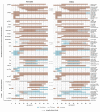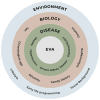Vascular ageing: moving from bench towards bedside
- PMID: 36738307
- PMCID: PMC7614971
- DOI: 10.1093/eurjpc/zwad028
Vascular ageing: moving from bench towards bedside
Erratum in
-
Erratum: Vascular ageing: moving from bench towards bedside.Eur J Prev Cardiol. 2023 Aug 21;30(11):1165. doi: 10.1093/eurjpc/zwad134. Eur J Prev Cardiol. 2023. PMID: 37155351 No abstract available.
Abstract
Prevention of cardiovascular disease (CVD) remains one of the largest public health challenges of our time. Identifying individuals at increased cardiovascular risk at an asymptomatic, sub-clinical stage is of paramount importance for minimizing disease progression as well as the substantial health and economic burden associated with overt CVD. Vascular ageing (VA) involves the deterioration in vascular structure and function over time and ultimately leads to damage in the heart, brain, kidney, and other organs. Vascular ageing encompasses the cumulative effect of all cardiovascular risk factors on the arterial wall over the life course and thus may help identify those at elevated cardiovascular risk, early in disease development. Although the concept of VA is gaining interest clinically, it is seldom measured in routine clinical practice due to lack of consensus on how to characterize VA as physiological vs. pathological and various practical issues. In this state-of-the-art review and as a network of scientists, clinicians, engineers, and industry partners with expertise in VA, we address six questions related to VA in an attempt to increase knowledge among the broader medical community and move the routine measurement of VA a little closer from bench towards bedside.
Keywords: Ageing; Cardiovascular disease prevention; Vascular damage.
© The Author(s) 2023. Published by Oxford University Press on behalf of the European Society of Cardiology.
Conflict of interest statement
Conflict of interest: None declared.
Figures




References
-
- Forum WE. The global economic burden of non-communicable diseases. Harvard School of Public Health; Boston, MA: 2011.
-
- Olsen MH, Angell SY, Asma S, Boutouyrie P, Burger D, Chirinos JA, et al. A call to action and a lifecourse strategy to address the global burden of raised blood pressure on current and future generations: the Lancet Commission on hypertension. Lancet. 2016;388:2665–2712. - PubMed
-
- Climie RE, Mayer CC, Bruno RM, Hametner B. Addressing the unmet needs of measuring vascular ageing in clinical practice-European cooperation in science and technology action VascAgeNet. Artery Res. 2020;26:71–75.
-
- Mayer CC, Climie RE, Hametner B, Bruno R-M. The European COST action VascAgeNet fostering innovation-when industry comes to science. Artery Res. 2020;26:125–129.

